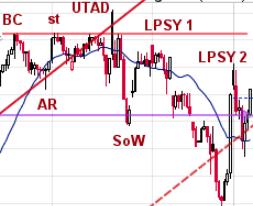Wyckoff At Work in the Intraday Timeframe
Trading in the intraday timeframe requires a deep understanding of market dynamics and price action. One of the time-tested methodologies that traders often turn to is the Wyckoff method. Developed by Richard D. Wyckoff, the Wyckoff method is based on principles of supply and demand, trend analysis, and market sentiment. In this article, we will explore how the Wyckoff method can be applied effectively in the intraday timeframe to identify trading opportunities and make informed decisions.
Understanding the Market Phases
In the Wyckoff method, the market is viewed as going through four distinct phases – accumulation, mark-up, distribution, and mark-down. Each phase represents a different stage in the price cycle and provides valuable insights into the intentions of market participants. In the intraday timeframe, these phases can be compressed, requiring traders to be nimble and quick in their analysis.
During the accumulation phase, smart money is seen accumulating positions at favorable prices before a potential mark-up phase begins. Intraday traders can look for signs of accumulation through price consolidations and volume spikes indicating increased buying interest. Once the mark-up phase kicks in, prices start trending higher, and traders can ride the momentum by entering long positions at strategic levels.
The distribution phase is where smart money starts offloading their positions to less informed market participants. Intraday traders need to watch out for price consolidations, decreasing volume, and signs of weakening momentum to identify potential distribution areas. As the market transitions into the mark-down phase, prices start declining, and traders can capitalize on shorting opportunities to profit from the downside.
Analyzing Price and Volume Relationships
Price and volume are key components in the Wyckoff method, and their interplay provides important clues about market sentiment and direction. In the intraday timeframe, traders can analyze price and volume relationships to confirm trends, identify reversals, and gauge market strength.
An increase in trading volume during a price move suggests strong player participation and validates the direction of the trend. Conversely, low volume during price moves could signal weak participation and potential trend reversals. Intraday traders can use volume analysis to confirm breakouts, assess trend strength, and anticipate potential turning points.
Combining price and volume analysis, Wyckoff traders in the intraday timeframe can develop a tactical approach to trading that leverages the power of supply and demand dynamics. By interpreting price action in conjunction with volume patterns, traders can make more informed decisions, manage risk effectively, and stay ahead of market movements.
Applying Wyckoff Principles in Intraday Trading
To effectively apply the Wyckoff method in the intraday timeframe, traders need to hone their analytical skills, practice patience, and remain disciplined in their approach. By studying price charts, analyzing volume trends, and identifying key support and resistance levels, traders can uncover potential trading opportunities with favorable risk-to-reward ratios.
Timing is crucial in intraday trading, and Wyckoff principles can help traders navigate the fast-paced nature of the market. By observing price fluctuations, monitoring volume surges, and staying alert to market developments, traders can make timely decisions and capitalize on short-term price movements.
In conclusion, the Wyckoff method offers a comprehensive framework for analyzing markets and making trading decisions in the intraday timeframe. By understanding market phases, analyzing price and volume relationships, and applying Wyckoff principles effectively, intraday traders can enhance their trading performance, minimize risks, and achieve consistent profitability in the dynamic world of intraday trading.

